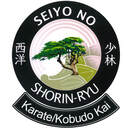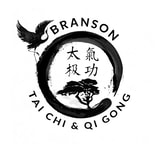|
When you step into our karate dojo, you may think you are merely learning the art of self defense.
However, once you are actively involved as a student, you’ll will find that karate is really a leadership academy. The skills taught are things like...
One leadership quality that has been proven to be more important to success in life over intelligence or any other quality is Time Management. In life, each of us are given the same number of hours per day. No one gets more than 24 hours in a day. The most successful people in the world that are masters at their craft, were never granted more than 24 hours per day to accomplish their tasks. What sets those who succeed in life apart from others is their ability to manage time. Whenever I hear someone say they don't have time for Karate I am disappointed. It tells me that the person is failing to manage their time and their life. They have not made their health or their dream of achieving a black belt in karate a priority. Here’s why saying “I don’t have time” is a poor excuse. Karate classes only run 60 minutes. You are to attend twice a week. There are 168 hours in a week. If you are at karate 3 hours per week (including drive time) that’s a mere 1.8% of your week. That’s a small spec in your time schedule! If you are not making classes it is because you are letting other people and other things manage your time. If you want to succeed in anything of importance in life you have to block out the time on your calendar and make it non-negotiable. Instead of allowing other things to steal your time, make a commitment to yourself that those class times are sacred. No one can take them from you. It’s YOUR time. Schedule your karate classes into your week. Time management is part of learning to be successful. Never give up on a dream just because of the time it will take to accomplish it. The time will pass anyway. ~ Earl Nightingale
2 Comments
In today's digital age we are fortunate as we can share information quickly to anyone that has access to a device with an internet connection. I have a personal goal to make karate training more accessible and easier to learn for anyone. In pursuing this goal, I've helped organize a curriculum database Web site that contains promotional checklists, detailed technique description sheets and kata outlines for each rank up to 1st Kyu (brown belt with a black stripe.) In working with other members of the Seiyo No Shorin-Ryu organization we have also started adding multimedia files such as videos and photos to rank sections. We believe this will be a tremendous training resource for all our members.
To access this new database, you will be required to register as a Seiyo No Shorin Ryu Karate & Kobudo Kai member. If you already have an up-to-date annual Seiyo No Shorin-Ryu Karate membership, you will be credited the membership registration fee. Colored belts (kyus) are $25/yr. Black belts (dans) are $50/yr. As this site is brand new, it is currently in BETA status. This means, that it's a work in progress. We appreciate any helpful suggestions or tracking of any errors that you may find. Please click on the "contact" page to send that feedback. Let's get started! Visit this link to access the new Web site: http://snsr.wildapricot.org/ NOTE: This is the BETA site address provided by our Web site database hosting service. The official Web site address will be http://www.seiyonoshorinryu.org and will be activated by June 1, 2013. So, don't bookmark the "wildapricot" address. The site will constantly be growing and improving as we add more photos, videos, helpful documents and tools.  Breathing is one of the best ways to relax and reduce stress. The saying, "Stress Kills" has a lot of truth to it. I believe that how we handle stress is what "kills" and causes many of our problems in life. If you are stressed out it can constrict blood vessels, prevent restful sleep, cause indigestion issues and other health problems. It can also lead to anger and even cause depression. Stress is anything that creates mental, physical or emotional strain in our lives. There are always going to be things in our lives that cause stress. Unfortunately, it's not possible to eliminate stressful things from happening to us. (Wouldn't life be boring without a little bit of stress?) However, you do have control of how you react to stress. Martial artists and other warriors, such as military soldiers, are often known for their calm demeanor under extremely stressful situations. When a life or death situation occurs they must be able to quickly evaluate the threat and react instantly. They cannot freeze, hesitate or overreact. Over reaction exerts too much energy that must be conserved to successfully finish out a battle. An experienced warrior often recalls later that, in the heat of battle, things seemed to slow down. It was as if time stopped and allowed them to see each opportunity clearly. Their breathing slowed, things came into focus and their body just naturally reacted. The key to their reaction appeared to be how they handled their stress and specifically, how they breathed. Breathing One of the best ways that I've found to relax and reduce stress is to breathe. You may be chuckling right now thinking, "I already breathe! I'd be dead if I didn't!" True. But, there are certain breathing techniques you can use to reduce stress in your life. If you get in the habit of using breath control techniques, when stressors do come into your life you will have a method of reducing the negative effects on your body. There are many different methods of breathing. One of which, that we practice in the dojo, is slow meditative breathing. In this type of breathing you breathe deeply in through your nose and out through your mouth. It is a cleansing breath that goes deep into your belly and fully exhales out. It's a way to clear your mind before class. There are other types as well, such as in the face of danger, take a quick but deep breath through your mouth and then exhale slowly through your nose. This provides additional oxygen to your muscles.Then, the slower exhale through your nose keeps the oxygen in your body longer to give you necessary energy. Below is a video that provides several alternative methods of breathing specifically for stress reduction. The video is produced by Sensei Roemke, who runs a dojo in Santa Cruz, California. I have no affiliation with him or his martial arts system, but I thought this particular video segment offered some excellent tips on breath control. Several of the techniques I use myself in my own personal meditations. If you are having trouble viewing the video, you may access it directly here: http://youtu.be/ZLJ2FJnty64
I am not being endorsed by or promoting the people in this video. I have no affiliation with them. The video was screened and approved for use on this blog based solely on the benefit found in the techniques demonstrated. On January 8, 2013 the videos were found to contain appropriate content for the topic of this blog. As the videos are linked to from YouTube, and can be changed by the owners of the videos at anytime, I am not responsible for any changes or deletions made by the owners. If you find the video no longer works or is not meaningful to this blog, please contact Vashon Borich.  Basic exercises you can do to increase overall body strength. In a past blog entry I discussed exercises you can do to increase flexibility. In this entry I will discuss some basic exercises you can do to increase overall body strength. The exercises I chose have been selected for their simplicity and use of little to no training equipment. I also have narrowed it down to four main exercises that produce excellent results for overall strength in muscle groups needed for the martial arts. Finally, I've provided a work out plan for beginners, intermediate and advanced students. 1. Push ups: start on the ground, feet apart for balance, hands positioned directly under your shoulders. Keeping your back and legs straight, push up with your arms and slowly lower yourself touching your chest to the floor for each count.
2. Air squats: Stand with feet shoulder-width apart with your toes, knees and hips in a straight line. Grasp your hands together and hold them straight out parallel to the floor. Pull your belly button toward your spine and contract your abdominal muscles. Slowly lower your body, as though you are sitting in a chair. Lower until your bottom is in line with your knees (knees at 90-degree angles). Make sure your knees are BEHIND your toes, your back is straight, and the weight is in your heels.
3. Leg lifts: lay on your back on the ground with legs fully extended. Tuck palms of hands under your bottom. Keeping legs straight and together, slowly lift heels about four inches off the ground. Tightening tummy, lift legs up further to 45 degree angle. That's one count. Slowly repeat to the four inch position. Do these reps very slowly to a cadence of 3 seconds per rep.
4. Pull ups: locate a pull up bar, kids jungle gym or sturdy rafter in your home. Grip the bar with fingers pointed away from you. Pull your body up so your chin goes over the bar.
After performing all four exercises, rest for one minute. That means you have completed one circuit. Repeat the circuit a minimum of twice and work up to repeating the circuit five times. Once you can repeat the beginning level five times, go ahead and bump up to intermediate. Once you can perform five circuits at the intermediate level, bump up to the advanced level. If five circuits at the advanced level is a snap for you then contact me for a new set of exercises to challenge you! For the best results perform all four exercises in circuits twice a week. 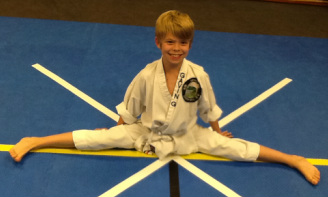 It's amazing watching an experienced karate practitioner throw a beautiful high kick over their own head. How flexible they must be! Martial artists are often known for their flexibility. But, flexibility isn't just important to performing incredible karate techniques. It also helps protect your body from injury and improves the range of motion of your joints as a whole. I sometimes hear adults say to me, I've never been flexible, even as a child, how could I possibly increase my flexibility now? I smile as I recall that I couldn't even touch my toes as a child but today, as an adult, I can do the splits. Flexibility can be learned and achieved at any age. While some people are naturally more limber than others, a stretching routine can allow any student to make progress in personal flexibility. In karate, one of the most talked about indicators of flexibility are the splits. There are two different types of "splits" -- the side splits and front splits.
I have included a couple of videos that demonstrate some excellent stretches specifically for performing the splits. Try utilizing these in your own personal stretching routine. Before long, you too may be doing the splits! If you are having trouble viewing the videos, here are the direct links to the YouTube versions: http://youtu.be/8Yd4Iag-dEA http://youtu.be/ywFJIdTSDIQ I am not being endorsed by or promoting the people in these videos. I have no affiliation with them. The videos were screened and approved for use on this blog based solely on the benefit found in the techniques demonstrated. On Nov. 28, 2012 the videos were found to contain appropriate content for the topic of this blog. As the videos are linked to from YouTube, and can be changed by the owners of the videos at anytime, I am not responsible for any changes or deletions made by the owners. If you find the videos no longer work or are not meaningful to this blog, please contact Vashon Borich.
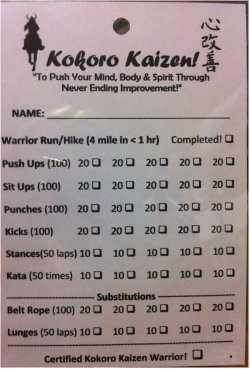 The Punch Card of challenges. The morning began earlier than most people choose to wake up on a Saturday morning. But these were no ordinary people. These were Kokoro Kaizen warriors. And, by 7 a.m. they were at my doorstep suited up and ready to push themselves to their limit in a morning full of challenges. After some warm-up stretches we were off to run/hike close to 4 miles on rugged terrain and up steep hills. I hoped my warriors were up for the challenge. Some ran, some walked and one even limped to the finish, but all of them completed the first challenge. Without much time to fully catch their breaths, we launched into a circuit of strenuous exercises that tested their mental fortitude, physical strength and tenacity. Dangling from a ribbon around their necks was a daunting punch card of exercises. Each exercise must be completed 50 to 100 times before the day was done. There were moments of frustration, exhaustion and even one who had to pause to empty the contents of his breakfast. But everyone pushed themselves to their limit. They impressed me with their spirit. They performed with the strength and passion of Samurai Warriors. Through sweat, grit and dirt they pressed on. By 11 a.m. everyone had completed their punch card and was certified as a Kokoro Kaizen warrior. We completed the day with a swim in the lake and a BBQ feast. Right now, I am beaming with pride for my students. I can't think of a better way to have celebrated our dojo's two-year anniversary. Thank you to all who came out. And, thank you to the parents, siblings and friends who helped with the event. I am honored to have such a great group. ~ Vashon Borich, Sensei You can view more photos from the 2012 Kokoro Kaizen celebration here: https://www.facebook.com/media/set/?set=a.492194880791920.118980.255052444506166& 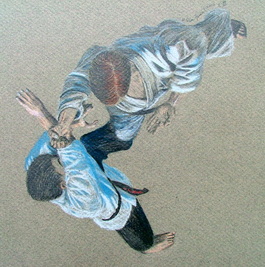 During our karate training there are certain roles we play in order to safely practice. We call these roles, Uke and Tori. The Tori is the "defender" or the person who successfully completes the technique. The Uke is the "receiver" or the person who usually initiates the attack and receives the throw, pin or lock. Sometimes the Uke is referred to as the "attacker" however, this is not accurate. In some cases, the Tori may initiate the attack or first more, the Uke counters and the Tori completes the defense technique. There is an art to being a good Uke and Tori. There is an important relationship between the two partners. If one partner doesn't perform their technique properly, with enthusiasm and in the correct way it could take away from the lesson or possibly even lead to injury. Are you being a good Uke or Tori? Here are some tips to help you become a better Uke and Tori.
|
AuthorVashon Borich-Leach, Sensei teaches traditional karate and tai chi in Branson, Missouri. She considers herself a life-time student of the arts. Her blog is an open journal of lessons learned in the martial arts. If you are a martial artist and would like to contribute to her blog please contact her. Archives
May 2023
Categories
All
©2012 Branson Karate & Kobudo™
|
©2010-2024 Vashon Enterprises LLC, DBA Branson Karate™
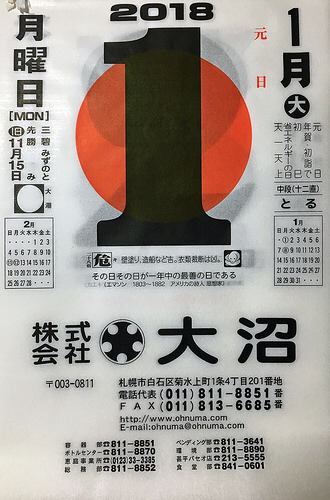
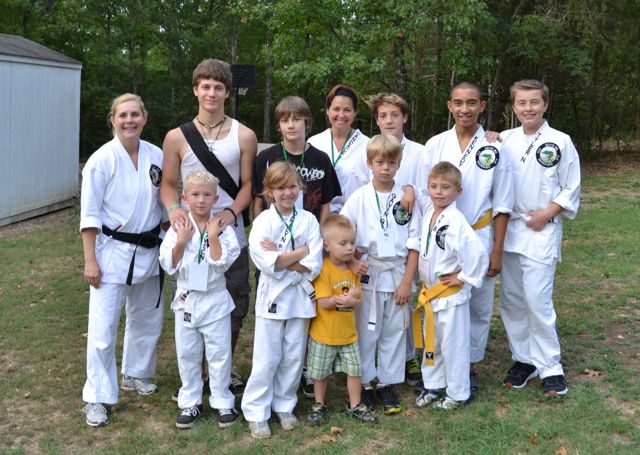
 RSS Feed
RSS Feed
